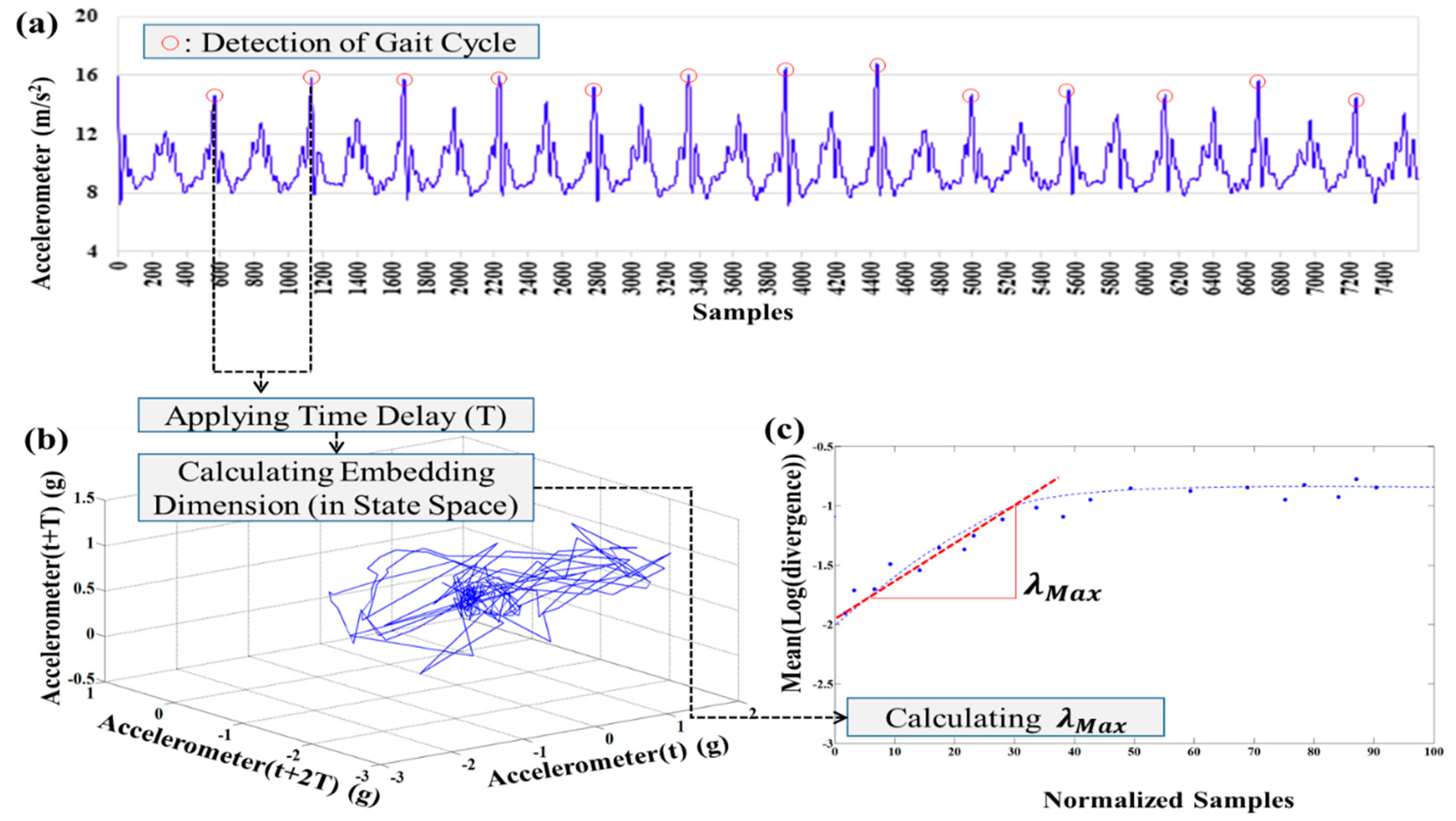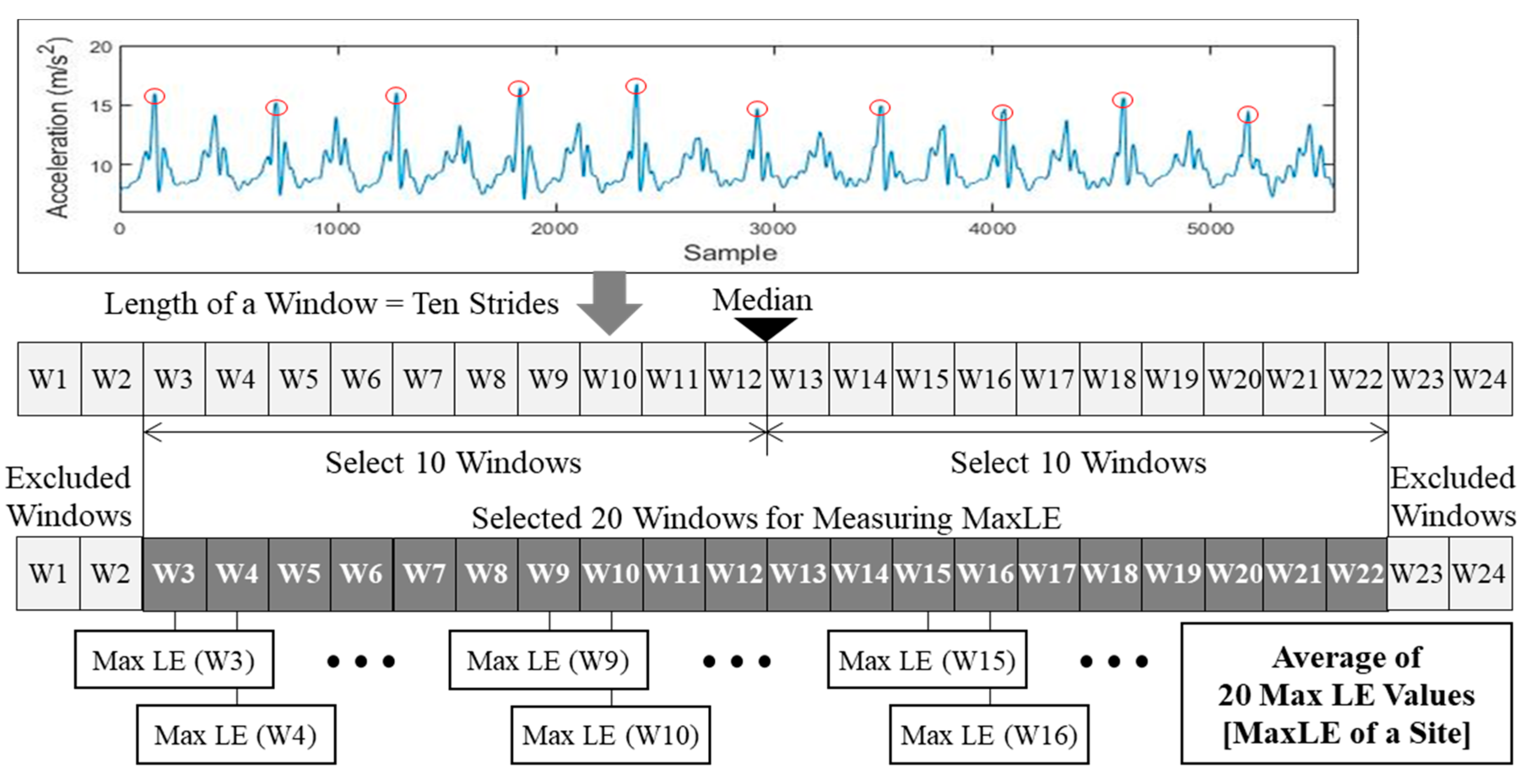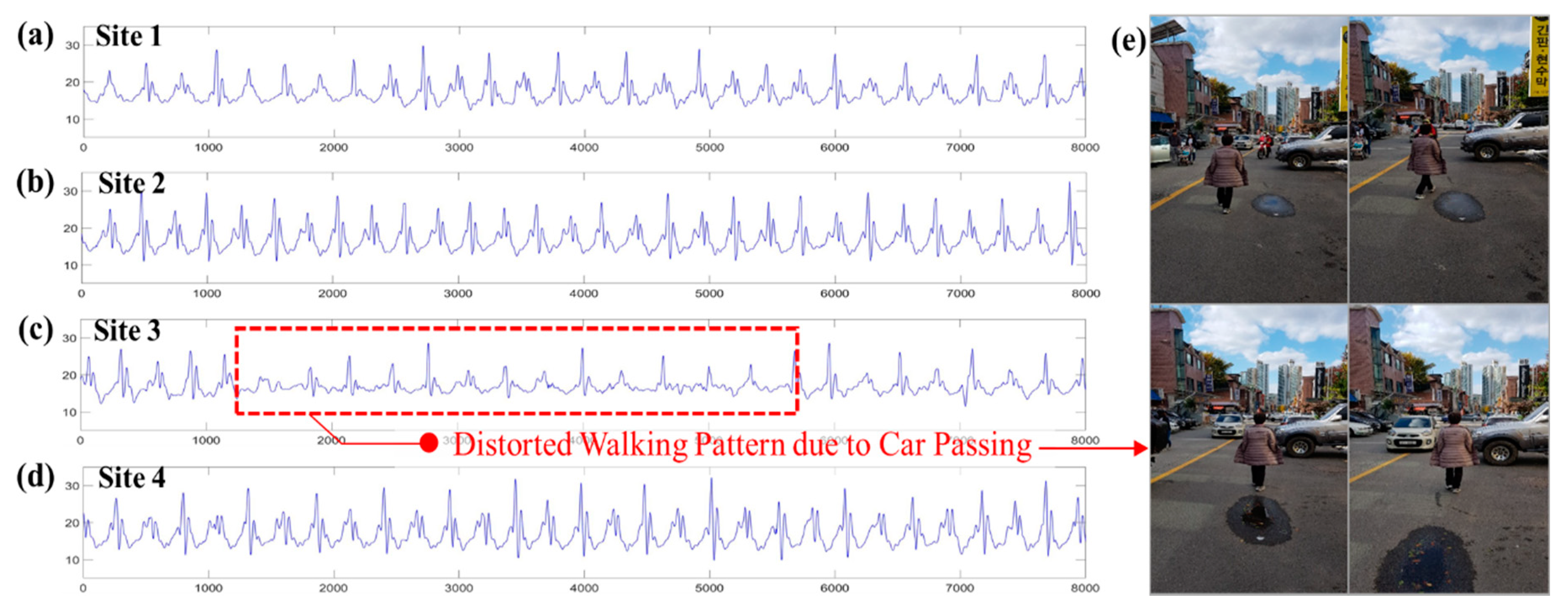Wearable Sensor Data-Driven Walkability Assessment for Elderly People
Abstract
1. Introduction
2. Experiment Design
2.1. Research Hypothesis
2.2. Experiment Site Selection
2.3. Participants
2.4. Experimental Procedure
2.5. Method for Calculating Dynamic Stability using MaxLE
3. Results
3.1. MaxLE-Based Walkability Measurement
3.2. Walkability Measured by Subjective Rating
3.3. Analysis of the MaxLE and Subjective Rating in the View of Walkability
4. Discussion
4.1. The Meanings of Incorporating Actual Users in Walkability Measurement
4.2. Limitations and Future Research
4.3. Envisioning the Use of the Suggested Method in Urban Environment Management
5. Conclusions
Funding
Conflicts of Interest
References
- Park, J.; Lee, S.; Yoo, S.H.; Jun, K.; Yeom, J.; Sung, M.; Son, I.; Lee, H.Y.; Suh, J.; Choi, H.; et al. The Socioeconomic Impact of Low Fertility and Population Aging on Family Structure; Korea Institute for Health and Social Affairs: Seoul, Korea, 2017. [Google Scholar]
- Mancini, J.A.; Orthner, D.K. Leisure time, activities, preferences, and competence: Implications for the morale of older adults. J. Appl. Gerontol. 1982, 1, 95–103. [Google Scholar] [CrossRef]
- Riddick, C.C. Leisure satisfaction precursors. J. Leis. Res. 1986, 18, 259–265. [Google Scholar] [CrossRef]
- Kelly, J.R. Activity and Aging: Staying Involved in Later Life; Sage Publications Newbury Park: Thousand Oaks, CA, USA, 1993. [Google Scholar]
- Kelly, J.R. Freedom to Be: A New Sociology of Leisure; Routledge: Abingdon, UK, 2019. [Google Scholar]
- WHO. Age-Friendly Environments. Available online: http://www.who.int/ageing/age-friendly-environments/en/ (accessed on 25 February 2020).
- Cerin, E.; Saelens, B.E.; Sallis, J.F.; Frank, L.D. Neighborhood environment walkability scale: Validity and development of a short form. Med. Sci. Sports Exerc. 2006, 38, 1682–1691. [Google Scholar] [CrossRef]
- Systematic Pedestrian and Cycling Environmental Scan (SPACES) Instrument. Available online: https://www.midss.org/content/systematic-pedestrian-and-cycling-environmental-scan-spaces-instrument (accessed on 3 March 2020).
- Clifton, K.J.; Smith, A.D.L.; Rodriguez, D. The development and testing of an audit for the pedestrian environment. Landsc. Urban Plan. 2007, 80, 95–110. [Google Scholar] [CrossRef]
- Hoehner, C.M.; Ivy, A.; Ramirez, L.K.B.; Handy, S.; Brownson, R.C. Active neighborhood checklist: A user-friendly and reliable tool for assessing activity friendliness. Am. J. Health Promot. 2007, 21, 534–537. [Google Scholar] [CrossRef]
- Kim, H.; Ahn, C.R.; Yang, K. A people-centric sensing approach to detecting sidewalk defects. Adv. Eng. Inform. 2016, 30, 660–671. [Google Scholar] [CrossRef]
- Campbell, A.T.; Eisenman, S.B.; Lane, N.D.; Miluzzo, E.; Peterson, R.A.; Lu, H.; Zheng, X.; Musolesi, M.; Fodor, K.; Ahn, G.-S.; et al. The rise of people-centric sensing. IEEE Internet Comput. 2008, 12, 12–21. [Google Scholar] [CrossRef]
- Lu, H.; Pan, W.; Lane, N.D.; Choudhury, T.; Campbell, A.T. SoundSense: Scalable sound sensing for people-centric applications on mobile phones. In Proceedings of the 7th International Conference on Mobile Systems, Applications, and Services, Krakow, Poland, 22 June 2009; pp. 165–178. [Google Scholar]
- Hussain, A.; Wenbi, R.; da Silva, A.L.; Nadher, M.; Mudhish, M. Health and emergency-care platform for the elderly and disabled people in the Smart City. J. Syst. Softw. 2015, 110, 253–263. [Google Scholar] [CrossRef]
- Sofia, R.; Firdose, S.; Lopes, L.A.; Moreira, W.; Mendes, P. NSense: A people-centric, non-intrusive opportunistic sensing tool for contextualizing nearness. In Proceedings of the 2016 IEEE 18th International Conference on e-Health Networking, Applications and Services (Healthcom), Munich, Germany, 14–17 September 2016; pp. 1–6. [Google Scholar]
- Mednis, A.; Strazdins, G.; Zviedris, R.; Kanonirs, G.; Selavo, L. Real time pothole detection using android smartphones with accelerometers. In Proceedings of the 2011 International Conference on Distributed Computing in Sensor Systems and Workshops (DCOSS), Barcelona, Spain, 27–28 June 2011; pp. 1–6. [Google Scholar]
- Kim, H.; Ahn, C.R.; Yang, K. Identifying safety hazards using collective bodily responses of workers. J. Constr. Eng. Manag. 2017, 143, 04016090. [Google Scholar] [CrossRef]
- Joo, S.; Oh, C. A novel method to monitor bicycling environments. Transp. Res. Part A Policy Pract. 2013, 54, 1–13. [Google Scholar] [CrossRef]
- Mourcou, Q.; Fleury, A.; Dupuy, P.; Diot, B.; Franco, C.; Vuillerme, N. Wegoto: A smartphone-based approach to assess and improve accessibility for wheelchair users. In Proceedings of the 2013 35th Annual International Conference of the IEEE Engineering in Medicine and Biology Society (EMBC), Osaka, Japan, 3–7 July 2013; pp. 1194–1197. [Google Scholar]
- Ai, C.; Tsai, Y. Automated sidewalk assessment method for americans with disabilities act compliance using three-dimensional mobile lidar. Transp. Res. Rec. 2016, 2542, 25–32. [Google Scholar] [CrossRef]
- Kim, J.-H. Reliability and validity of gait assessment tools for elderly person. J. Korean Phys. Ther. 2009, 21, 41–48. [Google Scholar]
- Noland, R.B.; Park, H.; Von Hagen, L.A.; Chatman, D.G. A mode choice analysis of school trips in New Jersey. J. Transp. Land Use 2014, 7, 111–133. [Google Scholar] [CrossRef]
- Park, H.; Noland, R.B.; Lachapelle, U. Active school trips: Associations with caregiver walking frequency. Transp. Policy 2013, 29, 23–28. [Google Scholar] [CrossRef]
- Bisadi, M.; Kim, H.; Ahn, C.R.; Nam, Y. Effects of physical disorders in neighborhoods on pedestrians’ physiological responses. In Proceedings of the Computing in Civil Engineering 2017: Information Modeling and Data Analytics, Seattle, WA, USA, 25–27 June 2017; pp. 183–190. [Google Scholar]
- Buzzi, U.H.; Stergiou, N.; Kurz, M.J.; Hageman, P.A.; Heidel, J. Nonlinear dynamics indicates aging affects variability during gait. Clin. Biomech. 2003, 18, 435–443. [Google Scholar] [CrossRef]
- England, S.A.; Granata, K.P. The influence of gait speed on local dynamic stability of walking. Gait Posture 2007, 25, 172–178. [Google Scholar] [CrossRef] [PubMed]
- Leipholz, H. Stability Theory: An Introduction to the Stability of Dynamic Systems and Rigid Bodies; Springer: Berlin/Heidelberg, Germany, 2013. [Google Scholar]
- Jebelli, H.; Ahn, C.R.; Stentz, T.L. Fall risk analysis of construction workers using inertial measurement units: Validating the usefulness of the postural stability metrics in construction. Saf. Sci. 2016, 84, 161–170. [Google Scholar] [CrossRef]
- Jebelli, H.; Ahn, C.R.; Stentz, T.L. The validation of gait-stability metrics to assess construction workers’ fall risk. In Proceedings of the International Conference on Computing in Civil and Building Engineering, Orlando, FL, USA, 23–25 June 2014; pp. 997–1004. [Google Scholar]
- Rosenstein, M.T.; Collins, J.J.; De Luca, C.J. A practical method for calculating largest Lyapunov exponents from small data sets. Phys. Nonlinear Phenom. 1993, 65, 117–134. [Google Scholar] [CrossRef]
- Wolf, A.; Swift, J.B.; Swinney, H.L.; Vastano, J.A. Determining Lyapunov exponents from a time series. Phys. Nonlinear Phenom. 1985, 16, 285–317. [Google Scholar] [CrossRef]
- Mehdizadeh, S. The largest Lyapunov exponent of gait in young and elderly individuals: A systematic review. Gait Posture 2018, 60, 241–250. [Google Scholar] [CrossRef] [PubMed]
- Bisi, M.C.; Riva, F.; Stagni, R. Measures of gait stability: Performance on adults and toddlers at the beginning of independent walking. J. Neuroeng. Rehabil. 2014, 11, 131. [Google Scholar] [CrossRef] [PubMed]
- Kugiumtzis, D.; Christophersen, N.D. State Space Reconstruction: Method of Delays vs Singular Spectrum Approach; University of Oslo: Oslo, Norway, 1997. [Google Scholar]
- Dingwell, J.B.; Cusumano, J.P. Nonlinear time series analysis of normal and pathological human walking. Chaos Interdiscip. J. Nonlinear Sci. 2000, 10, 848–863. [Google Scholar] [CrossRef] [PubMed]
- Abarbanel, H.D.; Kennel, M.B. Local false nearest neighbors and dynamical dimensions from observed chaotic data. Phys. Rev. E 1993, 47, 3057. [Google Scholar] [CrossRef] [PubMed]
- Kantz, H.; Schreiber, T. Nonlinear Time Series Analysis; Cambridge University Press: Cambridge, UK, 2004; Volume 7. [Google Scholar]
- Rosenstein, M.T.; Collins, J.J.; De Luca, C.J. Reconstruction expansion as a geometry-based framework for choosing proper delay times. Phys. Sect. D 1994, 73, 82–98. [Google Scholar] [CrossRef]
- Weiss, R.L.; Maantay, J.A.; Fahs, M. Promoting active urban aging: A measurement approach to neighborhood walkability for older adults. Cities Environ. 2010, 3, 12. [Google Scholar] [CrossRef]
- Cheng, H.D.; Shi, X.J.; Glazier, C. Real-time image thresholding based on sample space reduction and interpolation approach. J. Comput. Civ. Eng. 2003, 17, 264–272. [Google Scholar] [CrossRef]
- Kim, J.; Ahn, C.R.; Nam, Y. The influence of built environment features on crowdsourced physiological responses of pedestrians in neighborhoods. Comput. Environ. Urban Syst. 2019, 75, 161–169. [Google Scholar] [CrossRef]
- Saha, M.; Saugstad, M.; Maddali, H.T.; Zeng, A.; Holland, R.; Bower, S.; Dash, A.; Chen, S.; Li, A.; Hara, K.; et al. Project sidewalk: A web-based crowdsourcing tool for collecting sidewalk accessibility data at scale. In Proceedings of the 2019 CHI Conference on Human Factors in Computing Systems, Glasgow, UK, 4–9 May 2019; pp. 1–14. [Google Scholar]




| Information | Male (14 Persons) | Female (16 Persons) | |
|---|---|---|---|
| Height (cm) | Mean (SD) | 167.71 (6.12) | 154.56 (5.92) |
| Weight (kg) | Mean (SD) | 68.14 (5.85) | 64.25 (8.25) |
| Shoe Size (mm) | Mean (SD) | 250.71(10.33) | 226.88 (8.27) |
| Age (years) | Mean (SD) | 69.71 (4.68) | 68.06 (2.56) |
| Subject | MaxLEs on Site 1 | MaxLEs on Site 2 | MaxLEs on Site 3 | MaxLEs on Site 4 | ||||
|---|---|---|---|---|---|---|---|---|
| Mean | SD | Mean | SD | Mean | SD | Mean | SD | |
| Male 01 | 1.137 | 0.012 | 1.442 | 0.019 | 2.332 | 0.158 | 1.691 | 0.015 |
| Male 02 | 1.393 | 0.017 | 1.677 | 0.018 | 2.471 | 0.177 | 1.935 | 0.016 |
| Male 03 | 1.279 | 0.017 | 1.586 | 0.020 | 2.375 | 0.138 | 1.723 | 0.017 |
| Male 04 | 0.863 | 0.011 | 1.197 | 0.014 | 1.538 | 0.103 | 1.280 | 0.015 |
| Male 05 | 0.777 | 0.010 | 0.967 | 0.008 | 1.626 | 0.121 | 1.114 | 0.009 |
| Male 06 | 0.618 | 0.007 | 0.793 | 0.009 | 1.169 | 0.084 | 0.847 | 0.010 |
| Male 07 | 0.842 | 0.010 | 1.095 | 0.010 | 1.387 * | 0.096 | 1.093 | 0.013 |
| Male 08 | 1.169 | 0.014 | 1.630 | 0.018 | 2.134 | 0.128 | 1.727 | 0.021 |
| Male 09 | 0.783 | 0.009 | 0.948 | 0.011 | 1.303 * | 0.098 | 1.099 | 0.012 |
| Male 10 | 0.693 | 0.008 | 0.864 | 0.009 | 1.146* | 0.085 | 1.003 | 0.011 |
| Male 11 | 0.998 | 0.013 | 1.337 | 0.006 | 1.747 | 0.0012 | 1.477 | 0.009 |
| Male 12 | 1.181 | 0.009 | 1.547 | 0.011 | 1.783 * | 0.007 | 1.724 | 0.008 |
| Male 13 | 1.245 | 0.012 | 1.619 | 0.012 | 1.980 | 0.010 | 1.656 | 0.010 |
| Male 14 | 1.566 | 0.022 | 1.989 | 0.020 | 2.772 | 0.183 | 2.036 | 0.016 |
| Female 01 | 0.863 | 0.011 | 1.065 | 0.012 | 1.751 | 0.112 | 1.278 | 0.013 |
| Female 02 | 0.975 | 0.009 | 1.219 | 0.014 | 1.886 | 0.129 | 1.346 | 0.016 |
| Female 03 | 0.995 | 0.008 | 1.332 | 0.014 | 1.627 * | 0.112 | 1.473 | 0.015 |
| Female 04 | 0.863 | 0.011 | 1.065 | 0.012 | 1.751 | 0.112 | 1.278 | 0.013 |
| Female 05 | 0.689 | 0.008 | 0.923 | 0.009 | 1.323 | 0.096 | 1.031 | 0.011 |
| Female 06 | 0.659 | 0.007 | 0.812 | 0.007 | 1.306 | 0.088 | 0.876 | 0.009 |
| Female 07 | 0.728 | 0.007 | 1.005 | 0.010 | 1.200 * | 0.096 | 1.060 | 0.012 |
| Female 08 | 0.975 | 0.012 | 1.187 | 0.014 | 1.617 * | 0.127 | 1.275 | 0.017 |
| Female 09 | 0.890 | 0.010 | 1.179 | 0.014 | 1.679 | 0.113 | 1.225 | 0.016 |
| Female 10 | 0.679 | 0.007 | 0.840 | 0.010 | 1.247 | 0.081 | 0.898 | 0.010 |
| Female 11 | 0.672 | 0.007 | 0.825 | 0.011 | 1.392 | 0.092 | 0.951 | 0.011 |
| Female 12 | 0.869 | 0.010 | 1.149 | 0.009 | 1.583 | 0.100 | 1.199 | 0.012 |
| Female 13 | 0.745 | 0.007 | 0.954 | 0.008 | 1.899 | 0.014 | 1.110 | 0.014 |
| Female 14 | 0.677 | 0.010 | 0.934 | 0.012 | 0.995 * | 0.016 | 0.948 | 0.012 |
| Female 15 | 0.552 | 0.013 | 0.756 | 0.009 | 0.99 | 0.009 | 0.723 | 0.018 |
| Female 16 | 0.857 | 0.011 | 1.054 | 0.013 | 1.748 | 0.015 | 1.166 | 0.009 |
| Mean | 0.908 | 1.116 | 1.659 | 1.275 | ||||
| Subject | Subjective Rating on Site 1 | Subjective Rating on Site 2 | Subjective Rating on Site 3 | Subjective Rating on Site 4 | Mean |
|---|---|---|---|---|---|
| Male 01 | 9 | 6 | 2 | 5 | 5.50 |
| Male 02 | 9 | 7 | 4 | 6 | 6.50 |
| Male 03 | 9 | 5 | 3 | 5 | 5.50 |
| Male 04 | 9 | 8 | 4 | 5 | 6.50 |
| Male 05 | 9 | 6 | 2 | 3 | 5.00 |
| Male 06 | 7 | 5 | 1 | 4 | 4.25 |
| Male 07 | 8 | 5 | 1 | 3 | 4.25 |
| Male 08 | 9 | 5 | 5 | 3 | 5.50 |
| Male 09 | 7 | 6 | 2 | 6 | 5.25 |
| Male 10 | 7 | 5 | 4 | 6 | 5.50 |
| Male 11 | 8 | 7 | 1 | 6 | 6.25 |
| Male 12 | 7 | 6 | 1 | 5 | 5.75 |
| Male 13 | 9 | 7 | 2 | 6 | 6.75 |
| Male 14 | 9 | 6 | 2 | 6 | 6.5 |
| Female 01 | 9 | 7 | 3 | 5 | 6.00 |
| Female 02 | 9 | 7 | 2 | 6 | 6.00 |
| Female 03 | 8 | 6 | 3 | 5 | 5.50 |
| Female 04 | 8 | 7 | 1 | 4 | 5.00 |
| Female 05 | 9 | 5 | 1 | 4 | 4.75 |
| Female 06 | 7 | 5 | 4 | 5 | 5.25 |
| Female 07 | 7 | 6 | 5 | 6 | 6.00 |
| Female 08 | 9 | 8 | 4 | 6 | 6.75 |
| Female 09 | 8 | 6 | 3 | 5 | 5.50 |
| Female 10 | 9 | 6 | 4 | 5 | 6.00 |
| Female 11 | 9 | 7 | 2 | 5 | 5.75 |
| Female 12 | 9 | 8 | 2 | 4 | 5.75 |
| Female 13 | 9 | 7 | 4 | 4 | 6.00 |
| Female 14 | 9 | 7 | 3 | 5 | 6.00 |
| Female 15 | 8 | 7 | 3 | 6 | 6.00 |
| Female 16 | 9 | 8 | 2 | 6 | 6.25 |
| Mean | 8.40 | 6.37 | 2.67 | 5.00 | 5.72 |
© 2020 by the author. Licensee MDPI, Basel, Switzerland. This article is an open access article distributed under the terms and conditions of the Creative Commons Attribution (CC BY) license (http://creativecommons.org/licenses/by/4.0/).
Share and Cite
Kim, H. Wearable Sensor Data-Driven Walkability Assessment for Elderly People. Sustainability 2020, 12, 4041. https://doi.org/10.3390/su12104041
Kim H. Wearable Sensor Data-Driven Walkability Assessment for Elderly People. Sustainability. 2020; 12(10):4041. https://doi.org/10.3390/su12104041
Chicago/Turabian StyleKim, Hyunsoo. 2020. "Wearable Sensor Data-Driven Walkability Assessment for Elderly People" Sustainability 12, no. 10: 4041. https://doi.org/10.3390/su12104041
APA StyleKim, H. (2020). Wearable Sensor Data-Driven Walkability Assessment for Elderly People. Sustainability, 12(10), 4041. https://doi.org/10.3390/su12104041





